Viticulture Essential Edition - A Solo Review
22 Jan 2022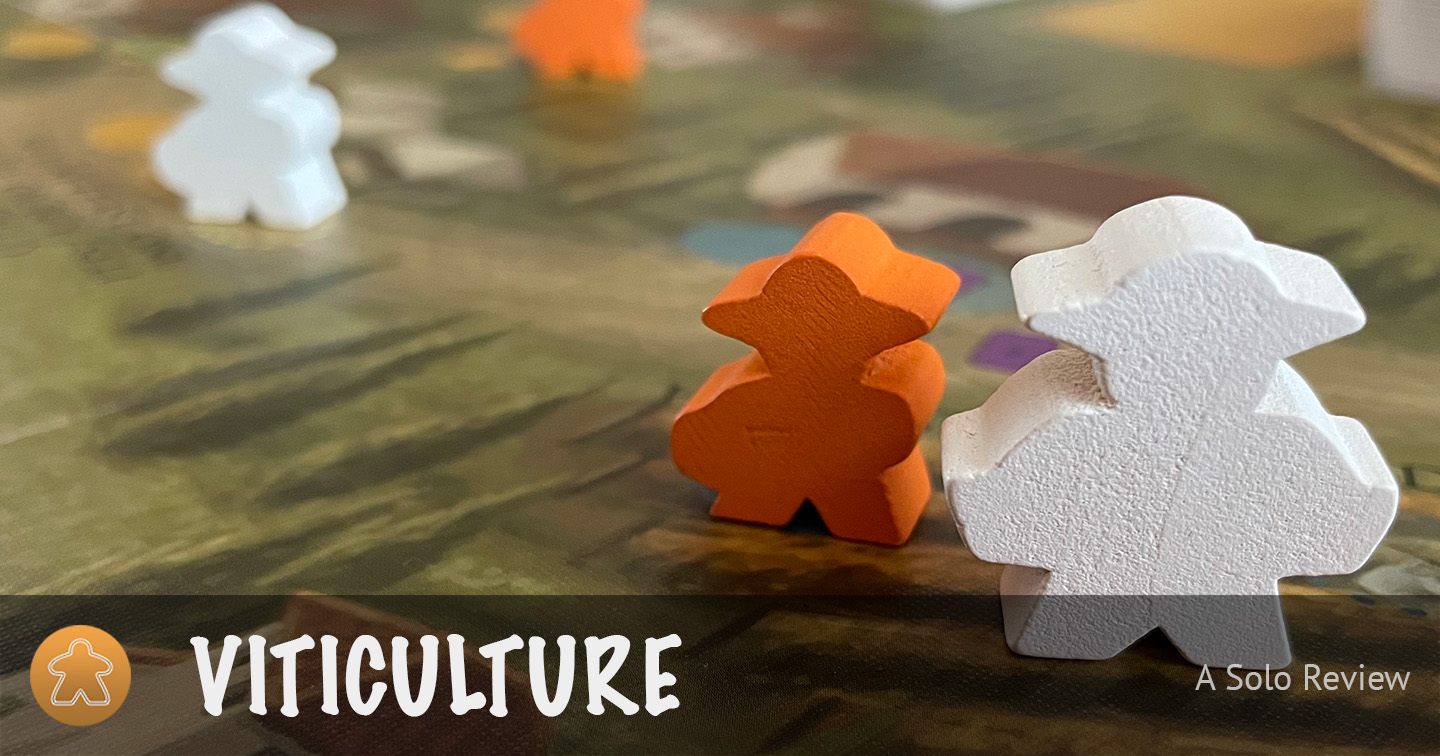
You have inherited a vineyard in Tuscany. While packing your bags you’re already dreaming of sitting between your grapes, enjoying your own wine, the sun setting behind you. When you arrive it appears time has stood still on your vineyard and it is not quite what you had expected. But there’s nothing that a little bit of hard work can’t fix. Can you realize a dream you never knew you had? Can you make Tuscany your new home?
Name: Viticulture Essential Edition
Designer: Jamey Stegmaier and Alan Stone (solo mode by Morten Monrad Pedersen)
Publisher: Stonemaier Games
Game type: worker placement
What is Viticulture?
Viticulture is a worker placement game which has you running a vineyard in Tuscany. In this game, the workers you have at your disposal are quite literally workers: they are the people you employ to do various tasks on your estate. In the game you score points by making and selling wine of various types and values. Inviting visitors during summer and winter can earn you numerous advantages, including more points. The first to reach 20 points wins. In the solo game your goal is gain more than 20 points in seven rounds with the AI sitting in your way.
How does it play?
A solo game of Viticulture is played over seven rounds, or years. Each year is divided into four seasons. The season you’re in determines what happens in the game or what you are allowed to do. Before we go over those seasonal details, let’s briefly talk about the setup of the game.
Apart from the basic setup like putting down the game board, adding four stacks of cards to it and taking a personal player board, there are only a few things you need to do.
The game comes with a bunch of Mama and Papa cards. You take two random cards of each type and select one Mama and Papa to keep. These two cards will determine your starting resources like an amount of Lira (the currency of the game), the number of workers you start with and your starting cards (e.g. two vine cards and one wine order card). The interesting thing about the Papa cards is that they offer you a choice between more money or something else, like a specific building or an extra worker.
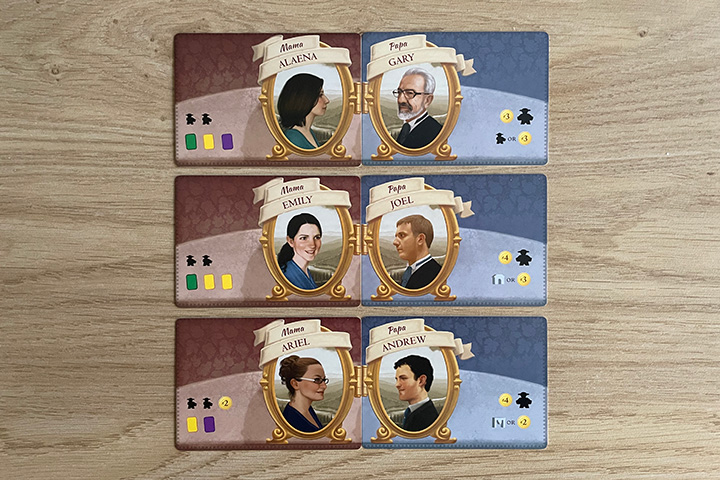
The second and final part you need to do is put a glass token on each of the seven places of the wake-up chart. In the solo game this wake-up chart is used as a round tracker.
Once that’s done, you are ready to start Spring of the first year!
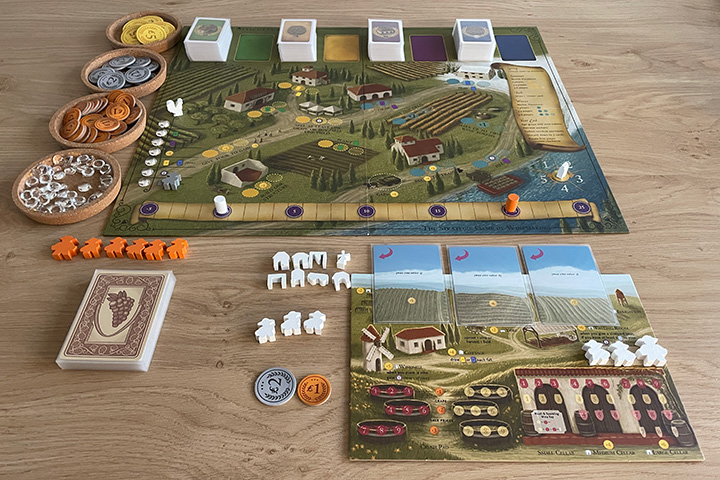
Spring
Spring is about choosing a benefit you want to receive that year. You do that by placing your rooster piece on a place on the wake-up chart that still has a glass token, taking the glass token while doing so. Each spot on the wake-up chart comes with a specific benefit and the glass tokens ensure that you can only take each benefit once. When you take the last glass token you also know that you’re going into the final year.
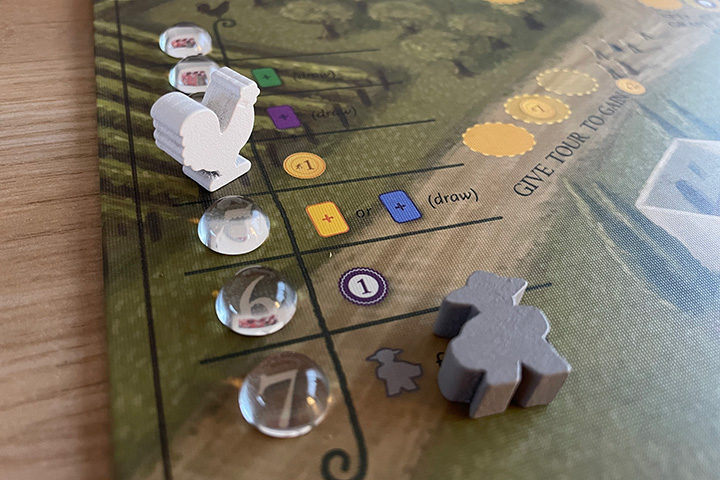
The benefits are things like drawing a card of a specific type, gaining a Lira, getting an extra worker for the current year, …
Once you have taken the glass token and your benefit, Spring is over and we go to summer. Time definitely goes fast in Tuscany!
Summer
Summer is a season where you can put your workers to… work. The worker placement spots on the board are divided into summer actions (yellow) and winter actions (blue). During summer you can only place workers on the yellow summer actions. Keep in mind that you only retrieve your workers at the end of the year, so if you want to place workers during the coming winter, you can’t use all of your workers during summer.
One important thing to keep in mind is that in a solo game, each action can only be taken once per season. The actions have three worker placement spots, but those are for games with three or more players; in a solo game you can only place a worker on the leftmost spot. The middle spot displays a bonus you gain when placing your worker there. But if you can’t place a worker there, how do you gain the bonuses? That’s where the glass tokens you get from the wake-up chart come into play. Whenever you place a worker, you can return such a glass token to the supply in return for the bonus of the action you’re taking. Since you’ll only gain seven of those tokens in a game, this means that you’ll only get to take seven bonus actions in a game. Think carefully about when to use them!
Back to the summer actions now!
The summer actions are all about preparing your vineyard for the upcoming harvest. I’ll quickly go over a few, but not all, actions:
- Draw a vine card. This lets you take a vine card from the face down stack of vine cards. A vine card represents a specific grape variety (e.g. Pinot, Syrah, Trebbiano, …) and tells you if can use it to make white wine, red wine or both. The grapes you can get from them also have a value, indicated on the card.
- Plant a vine. This lets you add a vine card from your hand to one of the three fields on your player board. Your fields have a capacity of five, six and seven and the total value of grapes on a field cannot exceed the field’s capacity. Some vine cards require certain buildings, like a trellis or irrigation, to be present on your vineyard before you can plant them.
- Build a building. This lets you build a building on your player board, if you have the Lira to pay for it. Buildings give you benefits or unlock things. The medium and large cellars are needed to store higher quality wines. The windmill gives you a victory point whenever you plant a vine.
- Play a summer visitor card. This lets you play a summer visitor card from your hand. There are 40 of these cards in the game and give you various one-off benefits. The Producer lets you retrieve two workers in exchange for two Lira. The Sharecropper lets you plant a vine card disregarding the required buildings or uproot and discard a planted vine to gain two victory points.
Once you’re done taking summer actions it is time for —you guessed it!— fall.
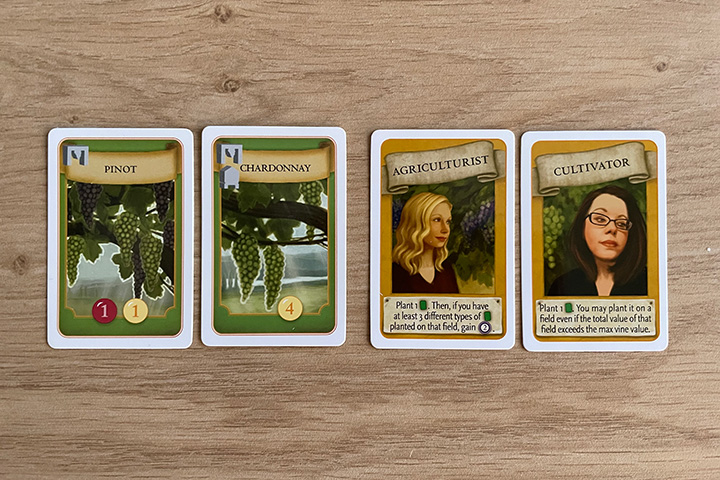

Fall
Fall is another short season like Spring. All you do here is draw a summer or a winter visitor card. If you have built a cottage you can draw an additional visitor card.
Winter is coming.
Winter
Winter is another worker placement season like summer. Summer was all about preparing your vineyard, winter is all about reaping the benefits of your hard summer work.
Let’s have a look at a few examples again:
- Draw a wine order card. This lets you take a wine order card. These cards show the types of wines and their values you need to turn in to be able to fulfill the order.
- Harvest a field. This gains you grapes. You choose a field with at least one vine on it, add the values of grapes of the same color (white and red) together and then cover those values with a glass token on the crush pads on your player board.
- Make up to two wine tokens. This lets you turn grapes in your crush pads into wine. A red grape of value 3 becomes a red wine of value three. If you have a medium cellar you can combine red and white grapes into blush wine. A large cellar allows you to combine two red and a white grape into sparkling wine.
- Fill a wine order. If you have the wines (type and value) required by a wine order card in your hand, you can remove the wine tokens in exchange for the victory points on the wine order card.
- Train a worker. Pay four Lira to get an extra worker you can start using next year.
- Play a winter visitor card. This is similar to playing summer visitor cards in summer.
When you’re done with your winter actions, the year is over.
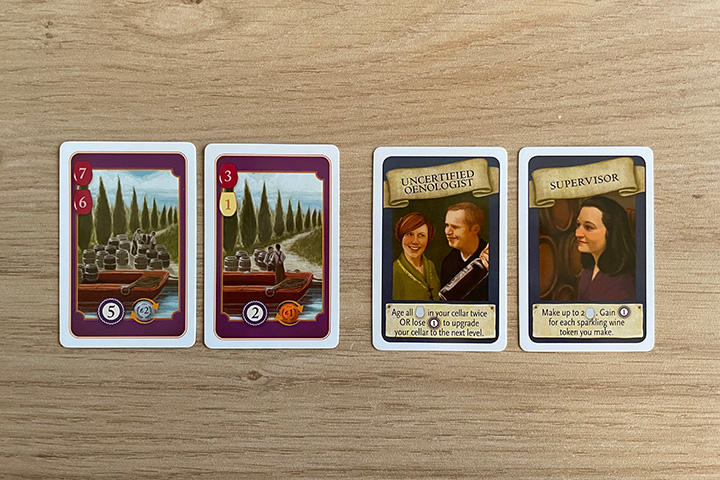
End of the year
At the end of the year you have to do a bit of upkeep before you can start the next year: your grape and wine tokens age, meaning they all increase in value, you retrieve your workers and you gain a residual payment. You start the residual payment tracker at zero, but every wine order you fill lets you add at least one. At the end of the year you gain Lira equal to the value of the tracker, up to a maximum of five.
And that’s basically it. You do this for seven years and then you compare your score to that of the AI. So how does the AI work exactly?
How does the AI work?
The AI is operated by a deck of 24 automa cards. Every summer and winter, before you start placing your workers, you flip over one automa card. This card tells you on which actions you should place a worker for the automa. The automa does not perform actions or gain benefits, it just blocks you from taking actions during summer and winter.
Luckily Viticulture has a way to work around that limitation once per year. You see, one of your workers is a bit bigger than the other workers. It is called a Grande worker and you can place it on an action that is already occupied! So if you really need to fill a wine order this year, but the automa has a worker there, you can use your Grande worker to take action anyway. At least, if you didn’t use the Grande worker during summer! Just like the glass tokens to use bonus actions, the Grande worker might take some planning.
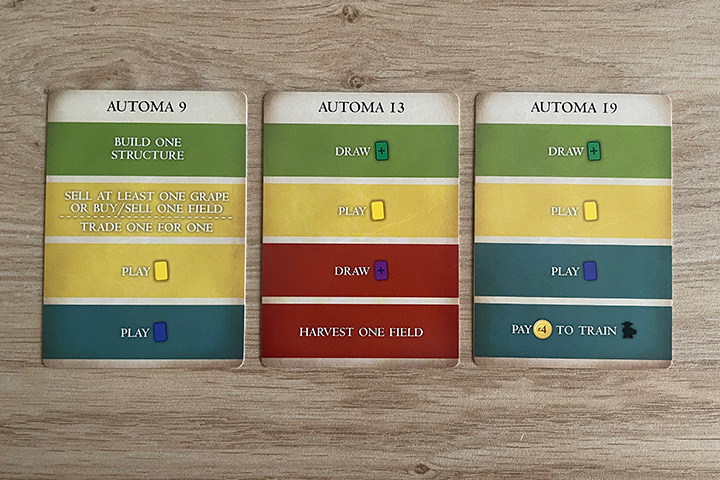
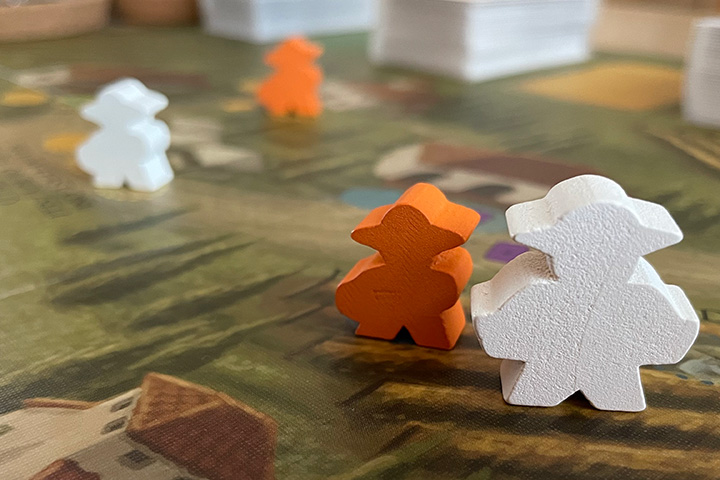
The AI starts the game with 20 points and since it doesn’t perform actions or gain benefits, it will also end the game with 20 points. This means that in order to win, you will need to score more than 20 points. Trust me, this sounds easier than it is!
What does it look and feel like?
The art in the game is done by Beth Sobel. It is very easy on the eye and really adds to the theme of the game. It might get down to personal taste, but I really like it and think it fits the game very well.
The quality of the cards is OK, but nothing special. I’ve sleeved mine, mostly because that makes it easier to shuffle all the different decks.
The wooden components are very nice. I like how the worker meeples have a distinct shape. If you see one in a picture somewhere, you’ll immediately recognize it as one from Viticulture. The buildings could have been simple cubes since you need to put them on dedicated places on your player board, but they are all uniquely shaped and are nicely shaped to match the buildings they represent. Nice!
The stars of show are the glass tokens. The different spots for grapes and wines on your player board have the value printed on them. When you put a glass token on top of such a spot, the curvature of the glass token beautifully enlarges the value. Because of the color of the grapes and wines underneath the token, it almost looks as if the glass token take over the color. Very well done!
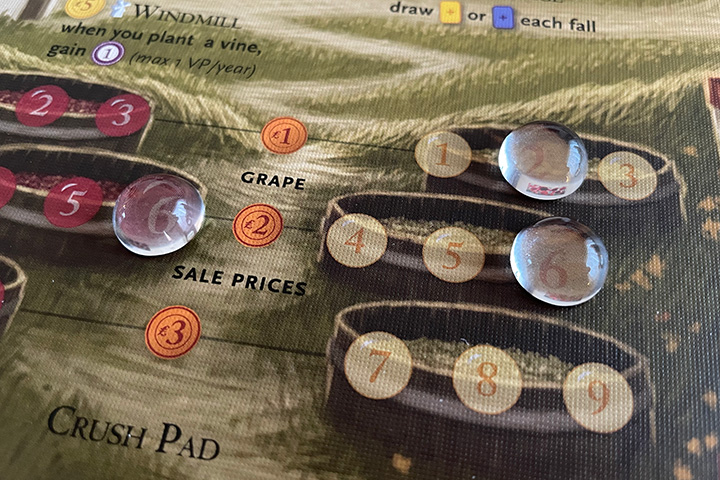
The only thing I didn’t like about this game was the insert. It was pretty worthless, so I immediately threw it out in favor of tuck boxes for the cards and plastic bags for the tokens. I was pleasantly surprised to see Jamey Stegmaier post pictures on Instagram of a brand new insert that’s included with the most recent printing. The new insert looks very nice and functional. Great to see Stonemaier Games listens to their customers!
How much time does it take?
The setup and teardown of a solo game is pretty quick. With the new insert (or the Folded Space insert I have but I still need to put together) I imagine it to be a matter of a few minutes.
The game itself probably depends on how susceptible to analysis paralysis you are. It can be pretty tight with the automa seeming to know which actions you were planning on taking, so I tend to take my time at the start of summer, thinking over the actions I want to take during the entire year and how I could react if the automa blocks certain spots.
All in all, I think I can play a game, including setup and teardown, in a bit over an hour.
What is my verdict?
On the one hand, the art style and the theme of the game, together with how different steps of making wine are divided into the different actions, make this a very relaxing game. On the other hand, the tightness and blocking automa can make it tense and really hard to win.
What I really appreciate is how easy and smooth the AI is. Just flip a card and place a few workers. You can really focus on your own game. Given how easy it is to operate, it is remarkable how it feels like a worthy opponent. It can really makes things hard for you.
Another thing that is very cleverly done is the Grande worker. This really adds an interesting element of planning and tactics to the game. Especially if you combine it with the 7 glass tokens you can collect to execute bonus actions. I also like how tight money can be in this game. You’ll never have enough money to build all buildings or hire all possible extra workers, so you have to make choices. The combination of these choices, the Grande worker, the bonus token and the money, make things very interesting and allows you to pursue different strategies.
One thing I don’t really like —or at least have mixed feelings about— is that, even though it is a game about making wine, you can’t really win just by focusing on making wine. If you want to get those 20 points in seven rounds, you’ll need some luck to get the right visitor cards come your way. Or maybe I’m just not good enough in the game, that’s also very possible. I’ve lost so many times that I’ve been considering of removing the AI’s score marker and just treating this as a beat your own score game.
That last point might feel more negative than it is. In the end, Viticulture is game I enjoy playing, but I have to be in the right mood for it.
Score
To make things easier for myself, I use the same scoring categories Board Game Geek uses.
Comments
I'm sorry, I don't support comments on my website. If you want to discuss the game or my review, feel free comment on this dedicated Instagram post or my review on BGG.